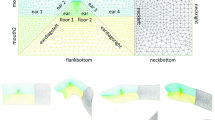Abstract
The paper presents the results of statistical evaluation of the changes of cellular apex connections, apical angles, and apical indices of ventral cells of the epiectodermal gastrula of Xenopus during the first four hours after the relaxation of mechanical tension. In the unrelaxed epithelium, an overwhelming majority of cells have three apical connections, apical angles close to 120°, and apical indices around one (isodiametric cells); after relaxation, the number of cells with more than three connections, the number of apical angles deviating substantially from 120°, and the percentage of columnar cells with high apical index increase. Apices with more than three connections tend to gather in enclosed groups, forming a straightened line of cell walls. The length and curvature of cell walls with four apical connections significantly exceeds those same indicators for cells with three apical connections. The observed changes in topology and geometry of cells correspond to reconstructions observed during normal morphogenesis. They are considered in terms of the hyper-restoration model of mechanical tension in relaxed epithelial layers.
Similar content being viewed by others
References
Arnolds, W.J.A., van den Biggelaar J.A.M., Verdonk N.H., Spatial Aspects of Cell Interactions, W. Roux. Arch. Devel. Biol., 1983, vol. 192, pp. 75–85.
Beloussov, L.V., Mechanically Based Generative Laws of Morphogenesis, Phys. Biol., 2008, no. 5, pp. 15009–15028.
Blankenship, J.T., Backovic, S.T., Sanny, J.S.P., et al., Multicellular Rosette Formation Links Planar Cell Polarity to Tissue Morphogenesis, Devel. Cell, 2006, vol. 11, pp. 459–470.
Brouzes, E. and Farge, E., Interplay of Mechanical Deformations and Patterned Gene Expression in Developing Embryos, Curr. Opin. Genet. Devel., 2004, vol. 14, no. 4, pp. 367–374.
Dumais, J., Can Mechanics Control Pattern Formation in Plants?, Curr. Opin. Plant Biol., 2007, no. 10, pp. 58–62.
Engler, A.J., Shamik, H., Sweeney, L., and Discher, D.E., Matrix Elasticity Directs Stem Lineage Specification, Cell, 2006, vol. 126, no. 4, pp. 677–689.
Glagoleva, N.S., Beloussov, L.V., Shtein, A.A., and Luchinskaya, N.N., A Quantitative Study of Regional and Stage Specific Reaction of Xenopus laevis Embryonic Tissues on Mechanical Load, Ontogenez, 2003, vol. 34, no. 4, pp. 292–300.
Isaeva, V.V. and Presnov, E.V., Topologicheskoe stroenie morfogeneticheskikh polei (Topologic Structure of Morphogenetic Fields), Moscow: Nauka, 1990.
McBeath, M., Pirone, D.M., Nelson, C.M., et al., Cell Shape, Cytoskeletal Tension and RhoA Regulate Stem Cell Lineage Commitment, Devel. Cell, 2004, vol. 6, pp. 483–495.
Nieuwkoop, P.D. and Faber, J., Normal Table of Xenopus laevis (Daudin), Amsterdam: North-Holland Publ. Co, 1956.
Ramasubramanian, A. and Taber, L.A., Computational Modeling of Morphogenesis Regulated by Mechanical Feedback, Biomech. Mod. Mechanobiol., 2008, vol. 7, no. 2, pp. 77–91.
Raucher, D. and Sheetz, M.P., Membrane Expansion Increases Endocytosis Rate during Mitosis, J. Cell Biol., 1999, vol. 144, pp. 497–506.
Savost’yanov, G.A., Osnovy strukturnoi gistologii. Prostranstvennaya organizatsiya epiteliev (Principles of Structural Histology. Spatial Organization of Epithelia), St. Petersburg: Nauka, 2005.
Truschel, S.T., Wang, E., Ruiz, W.G., et al., Stretch-Regulated Exocytosis: Endocytosis in Bladder Umbrella Cells, Mol. Biol. Cell, 2002, vol. 13, pp. 830–846.
Wagstaff, L.J., Bellet, G., Mogensen, M.M., and Münsterberg, A., Multicellular Rosette Formation during Cell Ingression in the Avian Primitive Streak, Devel. Dyn, 2008, vol. 237, pp. 91–96.
Wozniak, M.A. and Chen, C.S., Mechanotransduction in Development: A Growing Role for Contractility, Nat. Mol. Cell Biol., 2009, vol. 10, no. 1, pp. 34–43.
Author information
Authors and Affiliations
Corresponding author
Additional information
Original Russian Text © A.Yu. Evstifeeva, S.V. Kremnyov, L.V. Beloussov, 2010, published in Ontogenez, 2010, Vol. 41, No. 3, pp. 190–198.
Rights and permissions
About this article
Cite this article
Evstifeeva, A.Y., Kremnyov, S.V. & Beloussov, L.V. Changes in topology and geometry of the embryonic epithelium of Xenopus during relaxation of mechanical tension. Russ J Dev Biol 41, 156–163 (2010). https://doi.org/10.1134/S1062360410030033
Received:
Accepted:
Published:
Issue Date:
DOI: https://doi.org/10.1134/S1062360410030033



